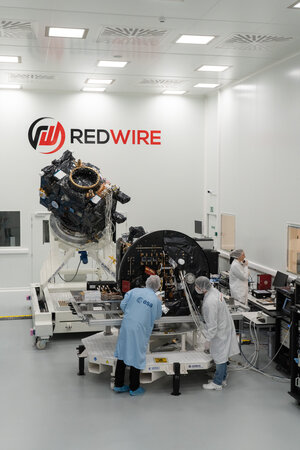Accept all cookies Accept only essential cookies See our Cookie Notice

About ESA
The European Space Agency (ESA) is Europe’s gateway to space. Its mission is to shape the development of Europe’s space capability and ensure that investment in space continues to deliver benefits to the citizens of Europe and the world.
Highlights
ESA - United space in Europe
This is ESA ESA facts Member States & Cooperating States Funding Director General Top management For Member State Delegations European vision European Space Policy ESA & EU Space Councils Responsibility & Sustainability Annual Report Calendar of meetings Corporate newsEstablishments & sites
ESA Headquarters ESA ESTEC ESA ESOC ESA ESRIN ESA EAC ESA ESAC Europe's Spaceport ESA ESEC ESA ECSAT Brussels Office Washington OfficeWorking with ESA
Business with ESA ESA Commercialisation Gateway Law at ESA Careers Cyber resilience at ESA IT at ESA Newsroom Partnerships Merchandising Licence Education Open Space Innovation Platform Integrity and Reporting Administrative Tribunal Health and SafetyMore about ESA
History ESA Historical Archives Exhibitions Publications Art & Culture ESA Merchandise Kids Diversity ESA Brand CentreLatest
Space in Member States
Find out more about space activities in our 23 Member States, and understand how ESA works together with their national agencies, institutions and organisations.
Science & Exploration
Exploring our Solar System and unlocking the secrets of the Universe
Go to topicAstronauts
Missions
Juice Euclid Webb Solar Orbiter BepiColombo Gaia ExoMars Cheops Exoplanet missions More missionsActivities
International Space Station Orion service module Gateway Concordia Caves & Pangaea BenefitsLatest
Space Safety
Protecting life and infrastructure on Earth and in orbit
Go to topicAsteroids
Asteroids and Planetary Defence Asteroid danger explained Flyeye telescope: asteroid detection Hera mission: asteroid deflection Near-Earth Object Coordination CentreSpace junk
About space debris Space debris by the numbers Space Environment Report In space refuelling, refurbishing and removingSafety from space
Clean Space ecodesign Zero Debris Technologies Space for Earth Supporting Sustainable DevelopmentLatest
Applications
Using space to benefit citizens and meet future challenges on Earth
Go to topicObserving the Earth
Observing the Earth Future EO Copernicus Meteorology Space for our climate Satellite missionsCommercialisation
ESA Commercialisation Gateway Open Space Innovation Platform Business Incubation ESA Space SolutionsLatest
Enabling & Support
Making space accessible and developing the technologies for the future
Go to topicBuilding missions
Space Engineering and Technology Test centre Laboratories Concurrent Design Facility Preparing for the future Shaping the Future Discovery and Preparation Advanced Concepts TeamSpace transportation
Space Transportation Ariane Vega Space Rider Future space transportation Boost! Europe's Spaceport Launches from Europe's Spaceport from 2012Latest

Proba-3's laser-precise positioning
Thank you for liking
You have already liked this page, you can only like it once!
An infrared view of a laser-based test campaign – performed by ESA, MDA and Centre Spatial de Liège personnel and taking place at Redwire Space in Kruibeke, Belgium – which represents crucial preparation for ESA’s precision formation flying mission, Proba-3.
Later this year, two satellites will be launched together into orbit to maintain formation relative to each other down to a few millimetres, creating an artificial solar eclipse in space. Proba-3’s ‘Occulter’ spacecraft will cast a shadow onto the other ‘Coronagraph’ spacecraft to block out the fiery face of the Sun and make the ghostly solar corona available for sustained observation for up to six hours per 19.5 hour orbit.
However to maintain the position of a shadow just a few centimetres across on the Coronagraph satellite from the Occulter satellite around 150 m away, the two satellites rely on a suite of sensors, including intersatellite radio links, GNSS, visual imaging and – for the most precise positioning at closest range – a laser metrology (or ‘measurement of measurement’) system. This system will shoot a laser from the Occulter spacecraft toward a corner cube retroreflector placed on the face of the Coronagraph spacecraft for tracking of relative position and attitude (pointing direction), achieving millimetre precision.
“To calibrate Proba-3’s laser metrology system, its performance was tested within the 60-m long Redwire cleanroom,” explains Damien Galano, Proba-3’s mission manager. “The Coronagraph’s laser was reflected off a retroreflector and the resulting positioning measurements checked against absolute ‘ground truth’ using a separate laser tracking system.”
This mission is being put together for ESA by a consortium led by Spain’s Sener, with participation by more than 29 companies from 14 countries. The Proba-3 platforms have been designed by Airbus Defence and Space in Spain and satellite integration by Redwire in Belgium. GMV in Spain is responsible for Proba-3’s formation flying subsystem while its main coronagraph instrument comes from Belgium’s Centre Spatial de Liège, CSL. Proba-3 is due to be launched by PSLV-XL launcher from India in September.
-
CREDIT
ESA - M. Pédoussaut / J. Versluys -
LICENCE
ESA Standard Licence

Proba-3: Firing laser!

Proba-3 Occulter and Coronagraph spacecraft

Proba-3 Coronagraph spacecraft

Proba-3 infographic: Spacecraft















 Germany
Germany
 Austria
Austria
 Belgium
Belgium
 Denmark
Denmark
 Spain
Spain
 Estonia
Estonia
 Finland
Finland
 France
France
 Greece
Greece
 Hungary
Hungary
 Ireland
Ireland
 Italy
Italy
 Luxembourg
Luxembourg
 Norway
Norway
 The Netherlands
The Netherlands
 Poland
Poland
 Portugal
Portugal
 Czechia
Czechia
 Romania
Romania
 United Kingdom
United Kingdom
 Slovenia
Slovenia
 Sweden
Sweden
 Switzerland
Switzerland
























